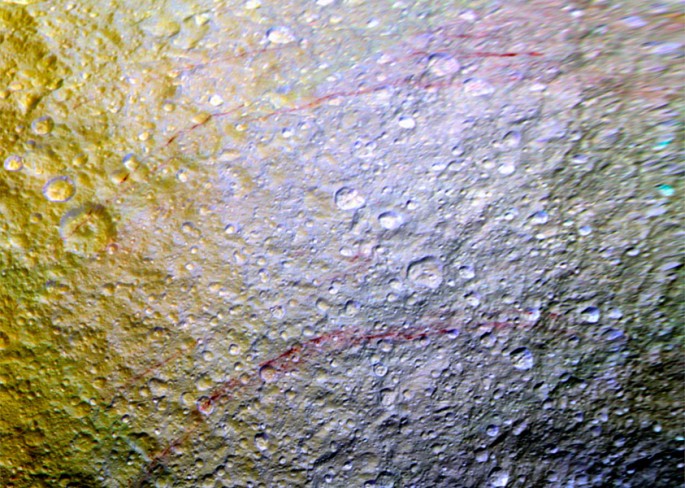One of Saturn's moons, Tethys, named after a mythical Greek Titan is a medium sized satellite that recently reveals some mysterious red streaks across its surface according to astronomers.
First spotted by the NASA's Cassini spacecraft, these unusual red streaks across Tethys measure hundred of miles in length via enhanced color images taken by the probe. The composite images were collected from ultraviolet and infrared observations and unaltered visible light with a green filter. This specific combination helps enhance the features of the moon that remains invisible to the naked human eye.
According to Cassini imaging scientist , Paul Helfenstein of Cornell University, these red streaks are estimated to be geologically young in formation since they cross older features similar to impact craters however, their age is still unknown.
Apart from the discovery of these ominous red streaks, the Cassini observatory also found a bright basin on the surface of Tethys which was never imaged before.
What makes Tethys unique from all the other known moons across the solar system is that its density is less than water. This bizarre quality is also known to possess by Saturn as well where astronomers believe that if Saturn could fit inside a bathtub filled with water, the gas planet will float.
This unusual moon has already been previously explored by several other spacecrafts such as the Pioneer 11 in 1979, Voyager 1 in 1980 and Voyager 2 in 1981 where Cassini arrived in the system in 2004. Cassini is also the first spacecraft to make the first complete orbit around Saturn.
This bright basin called Odysseus was imaged by the Cassini probe using a multi-wavelength imaging technique from a distance of 186,000 miles. The colorful basin measures 280 miles across where the moon only possesses a diameter of 660 miles. Astronomers also believe that this impact that formed the basin is pivotal in the formation of diverse geological features on the satellite.
After more than 10 years in space, the Cassini mission is getting ready for its final flyby, exploring the Saturn system and its satellite family. During its last epic flyby, its final maneuver will involve the probe flying through Saturn's ring plane and outskirts of its planetary atmosphere for never before seen, unprecedented views of its rings.



























